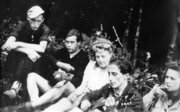Edelweiss Pirates
|
|
The Edelweiss Pirates (Edelweißpiraten) were a loosely organized youth culture in Nazi Germany. They emerged in western Germany out of the German Youth Movement of the late 1930s in response to the strict regimentation of the Hitler Youth. Similar in many ways to the Leipzig Meuten, they consisted of young people, mainly between the ages of 14 and 18, who had either evaded the Hitler Youth by leaving school (which was allowed at 14) or avoiding the Reich Labour Service and military service.
The origins of the Edelweißpiraten can be traced to the period immediately prior to World War II, as the state controlled Hitler Youth was mobilized to serve the state, at the expense of the leisure activities it had previously offered young people. This tension was exacerbated once the war began and youth leaders were conscripted. In contrast, the Edelweißpiraten offered young people considerable freedom to express themselves and to mingle with members of the opposite sex, whereas Nazi youth movements were strictly segregated by sex, the Hitler-Jugend (boys) and Bund Deutscher Mädel (girls). Though predominantly male, the casual meetings of the Edelweißpiraten even offered German adolescents an opportunity for sexual experimentation with the girls that tagged along with every group. The Edelweißpiraten used many forms and symbols of the organisations of the German Youth Movement, which were outlawed earlier. They used the tent, Kohte, the Jungeschaftsjacke and sang songs, all of which were prohibited symbols of German Youth Movement. These symbols and also the traditions such as hiking came from members, who were previously in the groups of the German Youth Movement.
Three-edelweiss-members.jpg
Ehrenfeld_Gedenktafel_Edelweißpiraten.jpg
Apart from gatherings on street corners, the Edelweißpiraten engaged in hiking and camping trips, which kept them away from the prying eyes of the authoritarian Nazi regime. They often engaged in fights with the Hitler Youth and took great pride in attacking them. As one group, the "Navajos", sang:
- Des Hitlers Zwang, der macht uns klein,
- (Hitler's compulsion makes us small)
- noch liegen wir in Ketten.
- (we're still bound in chains)
- Doch einmal werden wir wieder frei,
- (But one day we'll be free again)
- wir werden die Ketten schon brechen.
- (We'll smash through the chains)
- Denn unsere Fäuste, die sind hart,
- (For our fists, which are hard)
- ja--und die Messer sitzen los,
- (Yes, and we can draw our knives)
- für die Freiheit der Jugend,
- (For the freedom of Youth)
- kämpfen Navajos.
- (Navajos are struggling)
- Des Hitlers Zwang, der macht uns klein,
The Nazi response to the Edelweißpiraten was harsh. Individuals identified by the Gestapo as belonging to the various gangs were often rounded up and released with their heads shaved to shame them. In some cases, young people were sent to concentration camps or prison. On October 25, 1944, Heinrich Himmler ordered a crackdown on the group, and in November of that year, a group of thirteen Edelweißpiraten were publicly hanged in Cologne. Six boys, 16 years of age, were hanged in public, amongst them Bartholomäus Schink, called Barthel, leader of the local "Navajos." Fritz Theilen survived.
Nevertheless, government repression never managed to break the spirit of most groups, which constituted a subculture that rejected the norms of Nazi society. While the Edelweiss Pirates assisted army deserters and others hiding from the Third Reich, they have yet to receive recognition as a resistance movement (partly because they were viewed with contempt because of their 'proletarian' background and 'criminal' activities by many of their former Youth Movement comrades, who survived the war) and the families of victims killed by the Nazis have as yet received no reparations.
See also
External links
- The official website (http://www.edelweisspiraten.com/) of a film on the Edelweiss Pirates .
- Template:Imdb title
- An increasingly complex portrayal of German anti-fascism (http://www.wsws.org/articles/2005/mar2005/ber3-m05.shtml), an article discussing the films Edelweißpiraten and Sophie Scholl—The Final Daysde:Edelweißpiraten

